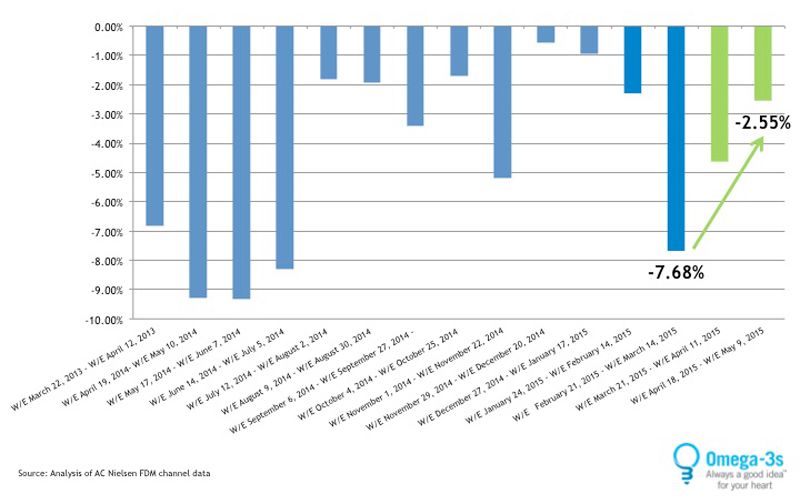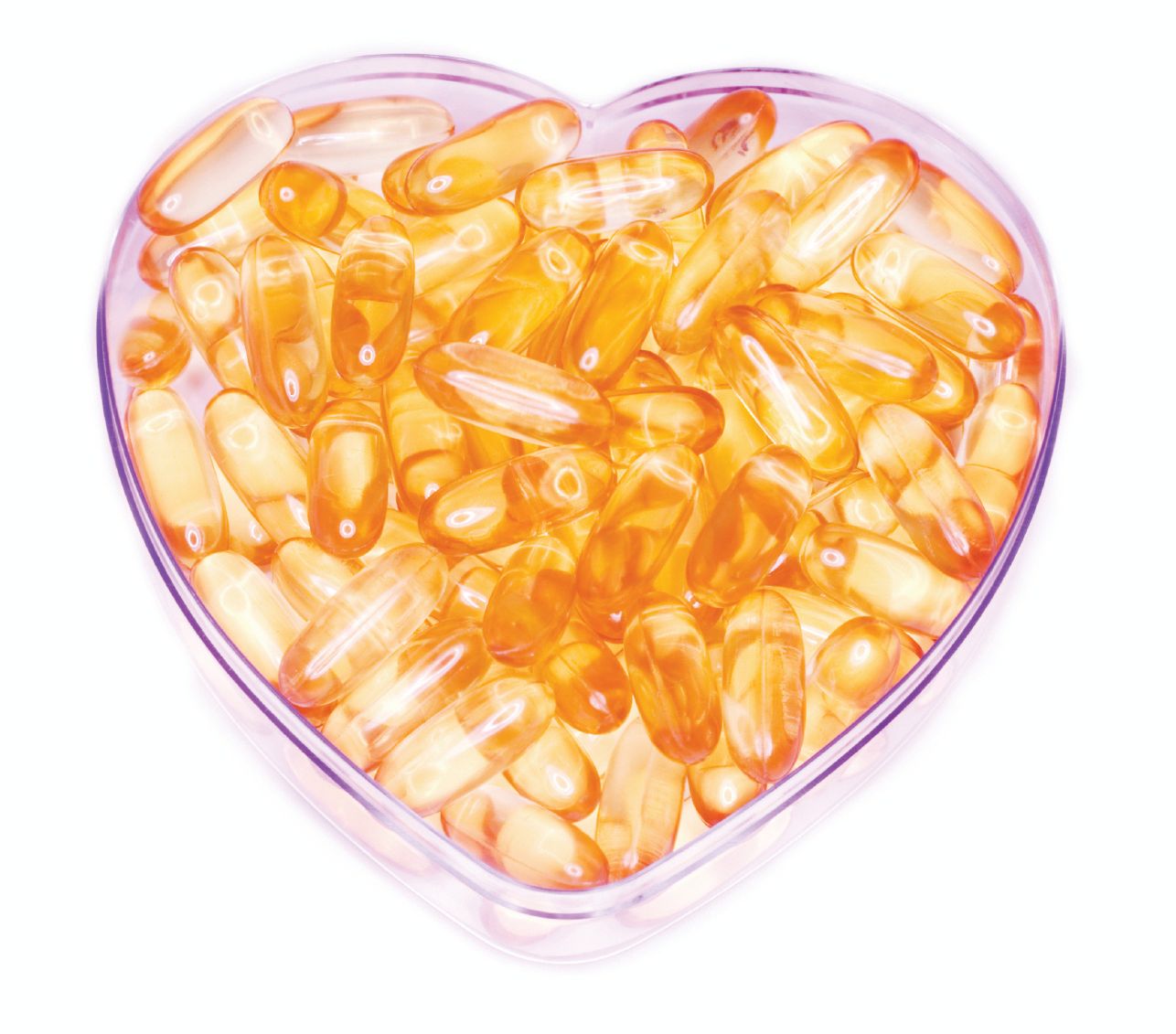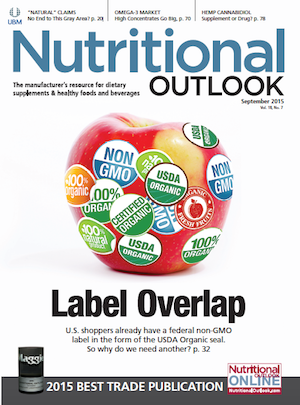Campaign to Revive Omega-3 Sales Helps Move the Needle
Despite running up against a negative New York Times article denouncing scientific support for fish oil, the GOED-led campaign showed positive results.


Photo by iStockphoto.com/Juxtagirl
Now that the “Omega-3s: Always a Good Idea” national advertising campaign is complete, what can we learn from the results?
To recap: In 2014, a coalition of omega-3 companies concerned about recent sales declines in the omega-3 category began working with the Global Organization for EPA and DHA Omega-3s (GOED; Salt Lake City, UT) on the advertising campaign to stimulate sales. The campaign first test-marketed in Charlotte, NC, last fall. Based on those learnings, the coalition moved forward with a national campaign that ran from mid-March to late May of this year. The campaign included television and digital advertising, the latter run through a partnership with Google. It also featured retail activation with in-store signage and an online retailer center, as well as integrated public relations and social media outreach.
The result? Final data show that year-over-year monthly unit food/drug/mass (FDM) sales increased more than 5% during the national campaign time frame.
What We Did
“The national campaign was different than what we did in Charlotte, based on what we learned during the test market,” explains Adam Ismail, GOED’s executive director. “We emphasized digital advertising much more heavily, and working with Google allowed us to draw on their data expertise to adjust the campaign on the fly and optimize ads based on real-time data.”
The national campaign also leveraged a network cable television purchase, giving the campaign visibility on stations including HGTV, The History Channel, Discovery, ESPN, and TBS.
Additionally, in-store signage appeared on shelves in CVS, Walgreens, Duane Reade, and a host of smaller, independent pharmacies, and was also promoted to 1300 natural retailers.
Campaign Analysis
While it was easy to see the effect of the campaign in Charlotte, analyzing the national campaign outcome was more complex. “The Charlotte campaign was pretty straightforward, and we were able to easily show the increase in sales,” says Ismail. “With the national campaign, there were a few factors that added ‘noise’ to the data.”
A big factor was the unfortunate timing of an article, titled “Fish Oil Claims Not Supported by Research,” published at the end of March in The New York Times and just a few weeks into the campaign.
“While this-and the resulting national media coverage-did hurt the [campaign’s] results,” Ismail says, “the impact was short-lived and the market rebounded relatively quickly.”
Another complicating factor was the fact that four key omega-3 brand SKUs, which together account for about 5% of the market, were being transitioned during the campaign, with old product pulled off shelves before new product became available.
At the end of the day, however, “we surpassed our goal of a 3% improvement in monthly year-over-year unit sales growth rate in the FDM channel,” Ismail says. (See figure below.)

U.S. Omega-3 SalesThe “Omega-3s: Always a Good Idea” national campaign ran from mid-March to May of this year. (See green bars.) The campaign correlated with a smaller sales dip, especially in light of several negative omega-3 headlines that appeared in the news at the same time the campaign was conducted.
Results Paint a Positive Picture
When analyzing the campaign results, “the challenge was digging into the data to understand what the market had done prior to the campaign launch,” Ismail says. Right before the campaign, for instance, the market experienced an unusual and notable 7.68% sales dip. Considering the fact that the campaign thus “had to climb up even more than expected” to overcome that initial deficit, Ismail says, the campaign’s results are positive.
The campaign’s effect also rippled through the natural channel. At the time this article was published, GOED was still waiting for natural-channel results for the final weeks of the campaign. What we do know is that in this channel, retail activation made a difference, and according to the coalition’s Market Research Committee, retail brands that used retail activation assets fared best. Ismail confirms, “We saw the same thing in the Charlotte test market. Having signage or a flyer at the point of purchase was definitely a driver of sales. This makes sense, as we believe that seeing a reminder is sometimes what people need to keep purchasing-and using-omega-3s.”
The coalition also conducted a consumer survey, the results of which showed a conservative estimate of a 1% increase in omega-3 usage.
Results based on the Omega-3 Coalition’s consumer survey conducted during the campaign.
While this is all good news, it’s important to note that the campaign did not return the market to growth, but Ismail discusses the reasoning behind that, too. “Simply, the campaign was underfunded,” he says. “To make an impression on consumers is extremely difficult in today’s media-saturated marketplace, and with a budget of less than $5 million, it was hard to move the needle. Having said that, we are happy with what was achieved and believe we did well with the budget we had.”
The Market Research Committee also estimated where the market would have gone in a normal cycle, without the effect of the campaign, using a regression model starting in December 2014. Comparing actual sales to the forecast indicates a possible sales increase of 7% as a result of the campaign.
Science Driving Future Initiatives
Now that the national advertising campaign is over, the coalition continues to work on public relation initiatives that reinforce the science-supported benefits of omega-3s. A Science Advisory Council, comprising a team of cardiovascular experts, researchers, and nutritionists, was formed to complement the coalition’s efforts to educate consumers about the benefits, efficacy, and safety of the omega-3s. Specifically, the council will provide independent scientific insights and perspectives regarding omega-3 claims for cardiovascular health, guide research on the connection between omega-3s and cardiovascular health, and broadly serve as advocates to peers and consumers for incorporating more EPA and DHA in the diet.
Members of the Omega-3 Science Advisory Council include:
- Cheryl Forberg, RD, a James Beard award-winning chef, The New York Times bestselling author, and the nutritionist for NBC’s “The Biggest Loser”
- Bill Harris, PhD, FAHA, FNLA, an internationally known expert on omega-3 fatty acids and how they benefit patients with heart disease
- Daniel Soffer, MD, FNLA, an internist and lipidologist with Penn Medicine of the University of Pennsylvania. He lectures regularly on lipid and lipoprotein metabolism and clinical management of lipid disorders and atherosclerosis.
- Marie Spano, MS, RD, CSCS, CSSD, a food and nutrition journalist, spokesperson, and frequent guest on national and regional TV stations
- In addition, Dariush Mozaffarian, MD, PhD, Dean of the Tufts University Friedman School of Nutrition Science and Policy and a board-certified cardiologist and epidemiologist, will serve as scientific consultant to the Omega-3 Coalition and GOED.
Ellen Schutt is communications director for the Global Organization for EPA and DHA Omega-3s (GOED; Salt Lake City, UT).
Also read:
How Omega-3 Companies Will Build the Bridge to Consumer Trust

Prinova acquires Aplinova to further increase its footprint in Latin America
April 7th 2025Prinova has recently announced the acquisition of Brazilian ingredients distributor Aplinova, which is a provider of specialty ingredients for a range of market segments that include food, beverage, supplements, and personal care.

























